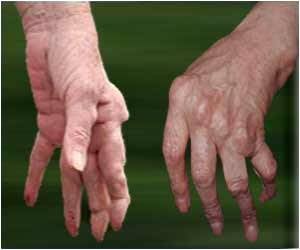Positive evolutionary selection has given rise to one of the most common height variants and arthritis risk factors known in human populations.

‘The intersection between evolution and medicine could help researchers learn more about the molecular causes of arthritis.’





After all, how could it be an advantage to be both shorter and less mobile in the cutthroat competition for scarce resources and fickle mates? Darwin's finches would be appalled. Now, researchers at the Stanford University School of Medicine and at Harvard University have shown that, despite its association with the painful joint disease, this genetic variant has been repeatedly favored as early humans migrated out of Africa and into colder northern climates. At least half of Europeans and Asians harbor the gene variant, which is relatively rare in African populations.
"Because it's been positively selected, this gene variant is present in billions of people," said David Kingsley, PhD, professor of developmental biology at Stanford. "So even though it only increases each person's risk by less than twofold, it's likely responsible for millions of cases of arthritis around the globe. This study highlights the intersection between evolution and medicine in really interesting ways, and could help researchers learn more about the molecular causes of arthritis."
A more compact body structure due to shorter bones could have helped our ancestors better withstand frostbite and reduce the risk of bone fracture from falling, the researchers speculate. These advantages in dealing with chilly temperatures and icy surfaces may have outweighed the threat of osteoarthritis, which usually occurs after prime reproductive age.
Cold may have selected for gene variant
Advertisement
A paper describing the research will be published online in Nature Genetics. Kingsley is the senior author. Harvard graduate student Jiaxue Cao and former Stanford postdoctoral scholars Terence Capellini, PhD, and Hao Chen, PhD, share lead authorship. Capellini is now an associate professor of human evolutionary biology at Harvard, and Chen is an associate clinical scientist at Genentech Inc.
Advertisement
In the new study, the researchers were interested in learning more about how the DNA sequences surrounding GDF5 might affect the gene's expression. Often, these noncoding sequences contain key regulatory regions known as promoters and enhancers. Capellini, Chen and Cao were able to identify a previously unknown enhancer region they termed GROW1, which is several thousand nucleotides downstream of GDF5.
When the researchers analyzed the sequence of GROW1 in the 1,000 Genomes Project database, which collects and compares sequences from many human populations around the globe, they identified a single nucleotide change that is highly prevalent in Europeans and Asians but that rarely occurs in Africans. When they introduced this nucleotide change into laboratory mice, they found that it decreased the activity of GDF5 in the growth plates of the long bones of fetal mice.
A common thread
Further research showed that this nucleotide change has been repeatedly favored during human evolution. Modern humans migrated from Africa between 50,000 and 100,000 years ago. But they weren't the first to leave the continent. Neanderthals and Denisovans moved north into Europe and Asia about 600,000 years ago. Interestingly, the researchers found that the same GROW1 variant was found in the DNA of both ancient and modern humans in Europe and Asia.
However, there's a dark side to this stocky, hardy body type: The GDF5 variant that reduces bone length comes hand-in-hand with the two upstream nucleotide changes known to confer an increased risk for osteoarthritis.
"It's clear that the genetic machinery around a gene can have a dramatic impact on how it works," said Capellini. "The variant that decreases height is lowering the activity of GDF5 in the growth plates of the bone. Interestingly, the region that harbors this variant is closely linked to other mutations that affect GDF5 activity in the joints, increasing the risk of osteoarthritis in the knee and hip."
"The potential medical impact of the finding is very interesting because so many people are affected," said Kingsley. "This is an incredibly prevalent, and ancient, variant. Many people think of osteoarthritis as a kind of wear-and-tear disease, but there's clearly a genetic component at work here as well. Now we've shown that positive evolutionary selection has given rise to one of the most common height variants and arthritis risk factors known in human populations."
Source-Eurekalert









